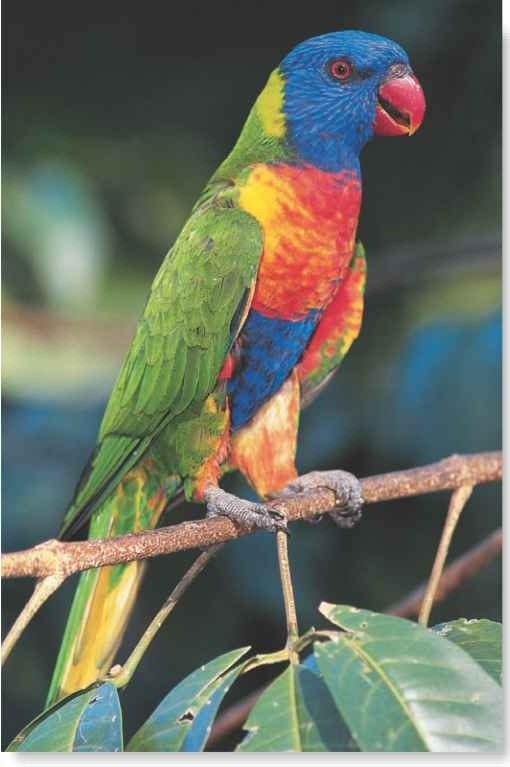ORDER
Psittaciformes
FAMILY
Psittacidae
GENUS & SPECIES
KEY FEATURES
• Also called the rainbow lory, the bird displays a cornucopia of colorfUl plumage
• With a world population in excess of 5 million birds, it is one of the most common species through much of its range
• To supply its daily energy needs, the lorikeet must take nectar from about 5,000 flowers
WHERE IN THE WORLD?
Found from Bali to Lombok, through many of the islands of Indonesia, New Guinea and the Solomons, into eastern and southeastern coastal Australia
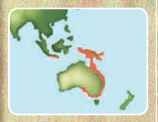
Lifecycle
With its bright and brassy plumage and friendly nature, the rainbow lorikeet is the most gaudy and gregarious bird in the south Pacific.
HABITAT
The rainbow lorikeet occurs in a wide variety of habitats, from human settlements to forest, coconut plantations, savannah, eucalyptus stands and mangroves. Although the lorikeet inhabits most types of lowland and wooded country within its range, including swamp forest and secondary growth, it tends to favor edges and disturbed vegetation rather than interior or closed-canopy formations, j Lorikeets typically occur from sea level to more than 2000′, but will occasionally ascend higher depending on the island’s elevation.

A Splash of color Lorikeets stand out in the forest branches.
BREEDING
Lorikeets tend to be nomadic and breed year-round, wherever and whenever trees and other plants are sufficiently in bloom to support the extra demands of rearing hungry families. Peak nesting tends to occur in the wet season, when the trees and shrubs come into flower Breeding has been observed during most months in Indonesia, New Guinea and northern Australia. Because they do not have a well-defined breeding season, lorikeets pair for life: this way they are ready to breed anytime conditions are favorable. The courtship display includes some wing-fluttering to reveal the colorful underwing pattern, swinging upside down, head-bobbing, tail-fanning and bill-fencing. The monogomous, life-long breeding pair builds their nest in a deep, unlined hole in the limb or trunk of a large tree. The female lays 2-3 white eggs, and the white-downed young hatch in around 25 days, fledging in 7-8 weeks. While only the female incubates the eggs, both concerned parents take turns caring for the young.
Happy couple Monogomous lorikeet breeding pairs stay together for life.

Extremely energetic rainbow lorikeets that inhabit small groups of closely clustered islands may fly back and forth from one to the other daily in search of food.
The rainbow lorikeet tongue is quite unlike that of other parrots, being furnished with a tuft of papillae, or extremely fine hairs; the lorikeet’s genus name, Trichoglossus, means “hair-tongued.”
BEHAVIOR
Active, belligerent and noisy, the rainbow lorikeet is fast and furious in flight, where it often comes within a few feet of an observer The lorikeet emits a sharp, rolling screech, repeated at regular intervals during flight. At rest, the lorikeet emits a soft twittering and loud, clear musical call. At dawn and the early part of the day, the birds feed on blossoms, often hanging upside down to reach them. During the hottest part of the day, they preen themselves and each other before settling down for a couple of hours. Later in the afternoon they feed again, chattering shrilly. Lorikeets wheel acrobatically as they come in to land at dusk. The birds are most often encountered in small, noisy groups, but communal roosts may involve many hundreds of birds. To bathe, lorikeets simply flap about in birdbaths or canopy foliage.
FOOD & FEEDING
The lorikeet is a specialized feeder, chiefly eating nectar and pollen. In fact, 87% of the lorikeet’s diet consists entirely of nectar— in one part of Australia, the lorikeet is found to enjoy about 43 different species of plants. However the lorikeet also enjoys the fruit of the ficus and trema plants, as well as the pupae of the ponciana moth.
As it flies from one flower to the next, the lorikeet uses its brushlike tongue to collect pollen and nectar from flowers.The papillae on the tip of the tongue are arranged into a fringe around the tip, working like a paintbrush to gather the pollen and nectar.The lorikeet’s gizzard is weak, since the bird ingests mainly nectar and pollen.

A Splish splash
A lorikeet bathes itself during an afternoon break.
CONSERVATION
Rainbow lorikeet populations are extremely strong. In fact, with a world population in excess of 5 million birds, the lorikeet is the most common bird through much of its range. Although abundant throughout much of New Guinea and other South Pacific areas, the lorikeet is rare on Bali. However, this is possibly due to the fact that it is a recent colonizer there from Lombok and has not yet / built up a strong flock.
FLOWER SHOPPING
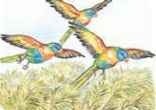
Out of town…
Rainbow lorikeets often have to fly long distances in search of pollinating flowers.
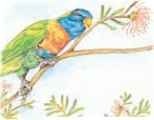
A Feeding ground…
The lorikeet walks up a thin branch of bottlebrush toward a large, red flower at the tip.
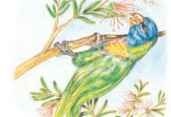
Upside down…
Agile feet allow the lorikeet to hang upside down and feed from the bottlebrush flower.

All around
The lorikeet’s unique tongue allows it to brush the flower to gather the pollen and nectar.
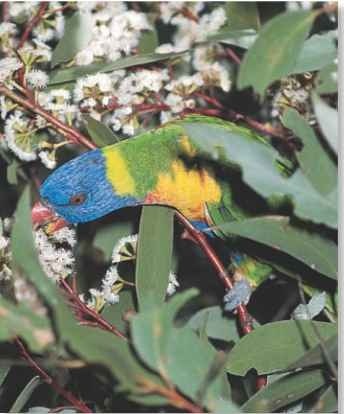
Profile
Rainbow Lorikeet
A brilliantly plumed, jewel-like bird, the lorikeet is easily recognized by its distinct coloration, heavy build and long tail.
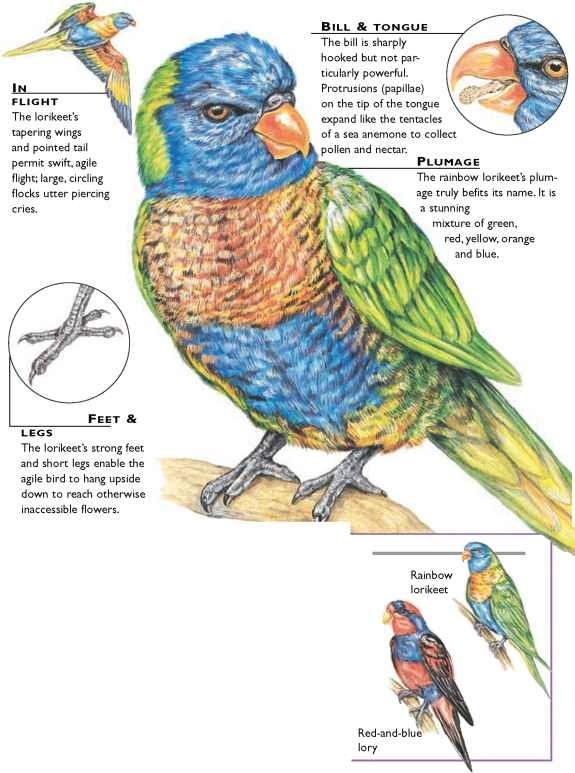
CREATURE COMPARISONS
At 12″, the red-and-blue lory (Eos histrio) is roughly the same size as the rainbow lorikeet. While its head and breast give it its colorful name, the red-and-blue lory is somewhat less colorful overall than the bright rainbow lorikeet. Preferring to live inside the forest, the red-and-blue lory can be seen visiting coconut plantations and other areas to feed from coconut, ficus and canarium trees, while the rainbow lorikeet tends to favor forest edges and vegetation. While the rainbow lorikeet spans through the islands of the South Pacific, the red-and-blue lory can be found on Miangas Island, north of Sulawesi.
| VITAL Weight |
STATISTICS 2.6-5.5 oz. |
| Length | 9-12” |
| Sexual Maturity | Unknown |
| Breeding : Season | Throughout the year . |
| Number 1 of Eggs . | 1-3 |
| Incubation Period | 25 days ‘ |
| Fledging f Period | 50-55 days |
| Breeding Interval | Less than 1 year |
| Typical Diet | Nectar, pollen and insects |
| Lifespan | Average 15 years in captivity; unknown in wild |
RELATED SPECIES
• Parrots and lories make up the family Psittacidae, I of 2 families in the order Psittaciformes, with the other family, Cacatuidae, – containing the cockatoos. With 78 genera and 332 species, the family Psittacidae includes the world’s only flightless parrot, the kaka-po (Strigops habroptilus), and several neotropical parrots, such as the red-and-green macaw, Ara chloroptera.
